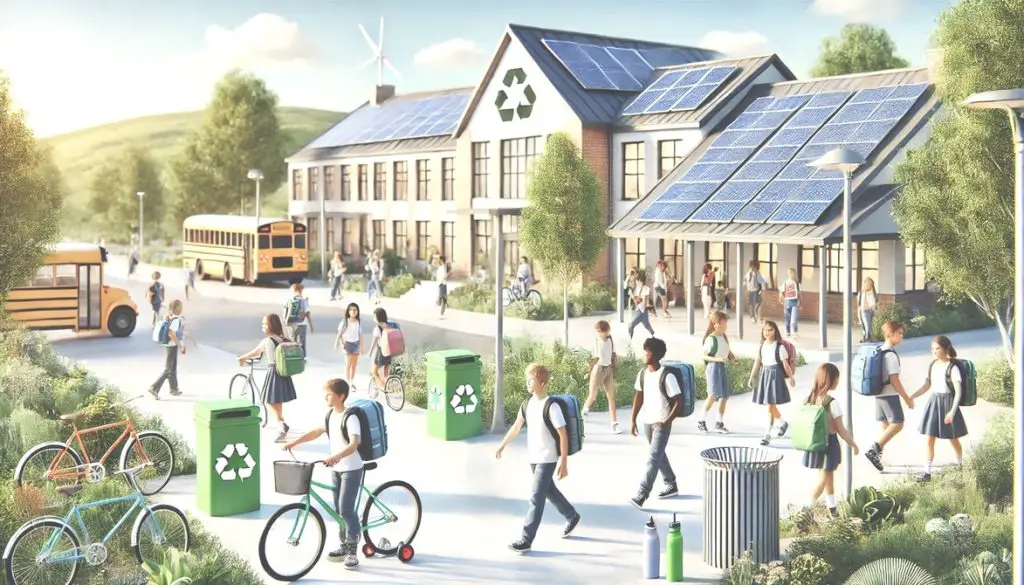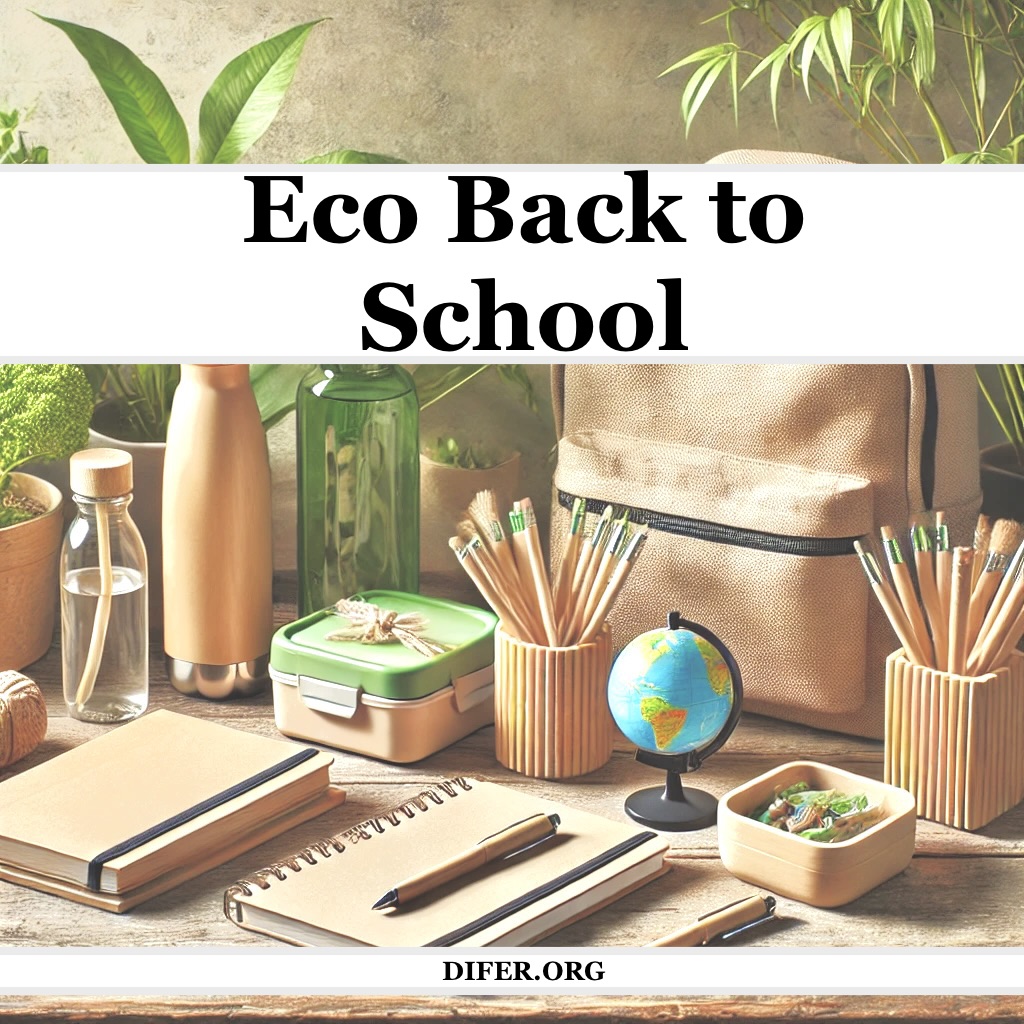Back to School time is the perfect time to embrace eco-friendly and sustainable practices. By making thoughtful choices, students and parents can reduce their environmental footprint and promote a greener future. Here are some practical tips and product recommendations to help you go back to school in an eco-friendly way.
This section includes affiliated links to highly rated, eco-friendly products.
Product Recommendations:
1. Opt for Eco-Friendly Backpacks
Choose backpacks made from sustainable materials like recycled polyester or organic cotton.
- JanSport Laptop Backpack: Every JanSport comes with a lifetime warranty. Made from 100% recycled main body fabric, 100% recycled lining, 100% recycled zipper tape and woven label. These backpacks are the last you will ever need to buy!
- Freakmandu Organic Hemp Backpack Bag: Made from eco-friendly natural hand-woven plain Hemp. It has premium fabric lining, strong stitching and comes with original Ykk zippers and a 100% customer satisfaction guarantee.
- Vera Bradley Women’s Recycled Cotton Campus Backpack: The exterior fabric is made with 50% recycled cotton fibers and has all of the comfort, softness, and vibrancy. These backpacks are well made and hold up extremely well.
- Second-Hand Shopping: Consider buying second-hand clothes and accessories to reduce waste and promote recycling.
2. Choose Sustainable School Supplies
Opt for school supplies made from recycled or sustainable materials. Look for products that are designed to last, reducing the need for frequent replacements.
- Onyx and Green Sugar Cane Fibers Notebooks: These notebooks are made of Sugar Cane Fibres and come in various sizes and styles.
- Pilot Bottle 2 Pen (B2P) Gel Roller Refillable Pens: Made from recycled plastic bottles. They feature G2 Ink, and are refillable and comfortable to hold. These pens are a sustainable writing option.
- Fainne Bulk Bamboo with Extra Black Ink Refills Retractable Ballpoint Pens: Crafted from sustainable bamboo, made of log, non-toxic, no smudging, no latex, wear resistant and reusable, comfortable to touch. Comes with plenty of refills for easy to fill replacements.
- Wood-Cased #2 HB Pencils, Pre-sharpened, 1200 Count Classroom Bulk Pack: High quality wood for easy sharpening. Buy these pencils in bulk and pay only $.05 per pencil saving you money, resources, and time in the long-run. Comes in a plastic-free, sturdy box.
3. Use Reusable Lunch Gear
Eliminate single-use plastic by investing in reusable lunch containers, water bottles, and utensils.
- Bambaw Stainless Steel Insulated & Reusable Water Bottle: Made of 18/8 stainless steel, the thermo water bottle is designed to last a lifetime. The wide opening and simple closing system makes the stainless steel insulated water bottle hygienic and easy to clean. This bottle is plastic-free! The water bottles metal are a safe option for you and the environment. To check out other great stainless steel bottles CLICK HERE
- Blockhütte Stainless Steel Leak-Proof Lunch Container: Made from high-quality, food-grade stainless steel this lunchbox is well-built, leak-proof, and easy-to-clean. It’s sturdy, easy to put into the dishwasher, and has plenty of room for a larger lunch.
- PlanetBox ROVER Classic Stainless Steel Bento Lunch Box: A stainless steel lunchbox with multiple compartments, perfect for a zero-waste lunch.
- Leakproof, Nesting Stainless Steel Food Storage Containers: Crafted from 304 stainless steel & food-grade silicone. These portable, reusable, lightweight, easy to clean containers with lids are 100% leak-proof. Take these snack boxes anywhere!
- American made ECO/EGO all in one Canvas Lunch Bag Set. 1 heavy duty waterproof waxed canvas lunch bag and 1 bamboo cutlery set with travel pouch: It uses a rare, soy-based, natural wax. As opposed to the more typical oil-based waxes, this soy version results in a much softer, dryer feel. Comes with everything you need to have an eco-friendly lunch. 1 fork. 1 spoon, 1 knife, 1 set chopsticks, 1 straw, and 1 cleaning brush.
- Portable Stainless Steel Flatware Set: This travel lunch utensils set is made of by high quality high quality food grade stainless steel ,reusable and durable for daily use. Easy to clean, the dishwasher safe.
4. Green Transportation
Encourage walking, biking, or carpooling to school to reduce carbon emissions. If public transportation is an option, it’s often more eco-friendly than individual car rides.
- ENGWE T14 600W(Peak) Folding Electric Bike for Adults Teens: A reliable bike for commuting to school, suitable for teen and adult riders. The compact size and ease of use of the bicycle make it an excellent option for eco-friendly local travel.
- Razor A Kick Scooter for Kids – Lightweight, Foldable, Aluminum Frame, and Adjustable Handlebars: A fun and eco-friendly way for kids to travel short distances. Top quality aluminum construction of the Razor A kick scooter is lightweight yet durable. Features our original folding mechanism for quick and easy carry, transport and storage between rides.
5. Digital Learning Tools
Minimize paper use by utilizing digital tools and resources. E-books, online assignments, and digital note-taking can significantly reduce the amount of paper consumed.
- Rocketbook Smart Reusable Notebook: Ditch piles of wasteful single-use paper with Rocketbook Core. Scan notes to the cloud, then wipe pages clear with the included cloth and reuse again and again. A reusable notebook with the ability to digitize notes.
- Amazon Kindle Paperwhite Signature Edition, 32 GB (newest model) – With auto-adjusting front light, wireless charging, 6.8“ display, and up to 10 weeks of battery life – Without Lockscreen Ads: An e-reader that allows students to carry multiple books without the need for physical copies. Great for traveling, has a matte screen, and adjustable lighting. Go hands-free – Pair with an Audible subscription and Bluetooth headphones or speakers to listen to your story.
6. Eco-Friendly Clothing
Choose clothing made from sustainable fabrics like organic cotton, bamboo, or recycled materials. Avoid fast fashion by investing in quality pieces that will last longer.
- Pact Organic Cotton Clothing: Offers a range of sustainable clothing options made from organic cotton.
- Mightly Fair Trade Cotton Kids’ Clothing: Known for their commitment to sustainability, Mightly offers durable and eco-friendly clothing for kids made from organic cotton fabrics from a Fair Trade Certified Factory.
- Buy SecondHand Clothing: Kids outgrow cloths fast. Buying something that already exist is the most eco-friendly way to get clothing.
7. Sustainable Study Habits
Create a green study space by using energy-efficient lighting and eco-friendly office supplies. Recycle old papers and donate books you no longer need.
- Philips Hue Go Smart Portable Dimmable Table Lamp: An energy-efficient lamp that provides bright light for studying. Create the ultimate mood lighting with dynamic light effects that show subtle changes in brightness and color. Customize in the app, control from anywhere and also control with touch or voice.
- Tree Free Copy Paper 8.5 x 11, 92 Bright, 20 lb. Made from Sugarcane Waste Fiber Carbon Neutral: Carbon-neutral multifunction paper. Made from 100% sugarcane waste fiber. Reliable sheet perfect for everyday use in laser, inkjet, and color printers and copiers. Carbon-neutral multifunction paper. Made from 100% sugarcane waste fiber. Reliable sheet perfect for everyday use in laser, inkjet, and color printers and copiers. This paper is a greener alternative to traditional paper.
- Universal Sugarcane Based Notebook, College Rule, 11 x 8-1/2, White, 100 Sheets/Pad: Sugarcane grows faster and reaches maturity much earlier than trees, making it an excellent, rapidly renewable alternative choice for high-quality paper. Sturdy paperboard backer and clear ruling help you take neat notes. Single-wire side binding. Microperforated pages for easy tear out. Divider features pockets for loose sheets
8. Waste-Free Snacks
Pack snacks in reusable containers and buy in bulk to reduce packaging waste. Avoid single-use plastics and pre-packaged foods. Choose organic and locally sourced foods whenever possible. If possible, use compostable items and start a compost bin for food scraps.
- Lerine 24 Pack Dishwasher Safe, Silicone, Extra Thick Leakproof, BPA Free Reusable Food Storage Bags: Perfect for storing snacks without the need for plastic bags. One of these bags can reduce the use of 450 single-use plastic bags, which has a significant environmental impact. At the same time, the reusable bags is also a more economical option for your household.
- Stainless Steel Snack Containers for Kids, Easy Open Leak Proof Small Food Containers with Silicone Lids: Durable and eco-friendly containers for snacks on the go. Reusable kids snack containers for kids made from high-quality 18/8 stainless steel and 100% leak proof silicone lids. CPSC certificated non-toxic, they are safe, healthy and eco-friendly.
9. Energy-Efficient Electronics
- Eco-Friendly Gadgets: If you need to buy new electronics, opt for energy-efficient models. Look for Energy Star-rated devices.
- Power Management: Turn off devices when not in use and use power strips to make it easy to shut down multiple devices at once.
10. Minimize Paper Use
- Digital Notes and Homework: Use digital devices for taking notes and doing homework to reduce paper consumption.
- Recycled Paper: When paper is necessary, use notebooks and paper products made from recycled materials.
11. Recycle and Reuse
- Proper Sorting: Make sure to recycle paper, plastic, glass, and metal properly. Educate yourself and others on local recycling guidelines.
- Use it up: Use supplies until they are no longer useful. This will help eliminate unnecessary waste.
- Upcycle Projects: Get creative with upcycling old school supplies and materials into new, useful items.
Going back to school with an eco-friendly mindset can make a significant difference for the environment. By choosing sustainable products, reducing waste, and adopting green habits, students and parents can contribute to a healthier planet. These small changes not only help the environment but also set a positive example for future generations.

Eco-Friendly Ways to Reduce Waste with Kids
Teaching kids about reducing plastic waste is a wonderful way to foster environmental responsibility from a young age. Here are some practical and fun ways to engage children in eco-friendly practices:
1. Reusable Lunch Gear
- Switch to Reusable Containers: Use stainless steel or BPA-free plastic containers instead of single-use plastic bags. Include reusable utensils, cloth napkins, and a water bottle.
- Creative Lunch Ideas: Involve kids in packing their lunch using fun, reusable containers. This not only reduces waste but also makes lunchtime exciting.
2. Eco-Friendly Craft Projects
- Natural Craft Materials: Encourage the use of natural materials like leaves, stones, and sticks for art and craft projects instead of synthetic ones.
- Upcycling Crafts: Turn plastic waste into creative art projects. For example, use empty bottles to make planters or bird feeders. This teaches kids about reusing materials creatively.
3. Plastic-Free Shopping
- Reusable Shopping Bags: Teach kids to carry reusable shopping bags and explain the importance of reducing plastic bag use.
- Bulk Buying: Involve kids in shopping for bulk items using reusable containers to minimize packaging waste.
4. DIY Household Products
- Homemade Cleaning Products: Make simple cleaning products at home using ingredients like vinegar and baking soda. Kids can help mix and label the products.
- Natural Personal Care: Create natural personal care items like soaps and lotions with kids, reducing the need for plastic packaging.
5. Educational Activities
- Plastic Pollution Lessons: Use books, documentaries, and online resources to teach kids about the impact of plastic pollution on the environment.
- Interactive Games: Play educational games that focus on sorting recyclables, identifying eco-friendly practices, and understanding waste management.
6. Gardening and Composting
- Start a Garden: Planting a garden helps kids understand the life cycle of plants and the importance of reducing waste. Use biodegradable pots and organic methods.
- Composting: Teach kids to compost food scraps, reducing the amount of waste that goes to landfills. They can help maintain the compost bin and learn about decomposition.
7. Zero-Waste Challenges
- Family Challenges: Set up family challenges to see who can produce the least amount of plastic waste in a week. Reward eco-friendly behaviors with fun activities or small prizes.
- School Initiatives: Encourage schools to adopt zero-waste policies and involve kids in projects to reduce plastic waste on campus.
8. Community Clean-Up Events
- Organize Clean-Ups: Participate in or organize local clean-up events. Kids can help collect plastic waste and learn about its impact on the environment.
- Recycling Education: Teach kids how to properly sort recyclables and understand the recycling process.
Benefits of Involving Kids in Reducing Plastic Waste
- Environmental Awareness: Kids learn about the impact of plastic waste and the importance of protecting the environment.
- Responsibility: Engaging in eco-friendly practices fosters a sense of responsibility and stewardship for the planet.
- Creativity and Problem-Solving: Kids develop creative thinking and problem-solving skills through upcycling and DIY projects.
- Healthy Habits: Establishing eco-friendly habits early in life leads to sustainable practices in adulthood.
Sources
- National Geographic Kids – Plastic Pollution
- Earth911 – Teaching Kids About Plastic Pollution
- World Wildlife Fund – Plastic Waste and Pollution
- EPA – Reducing and Reusing Basics
By incorporating these activities into your routine, you can help children understand the importance of reducing plastic waste and inspire them to make eco-friendly choices.

Sources
- EPA – Reduce, Reuse, Recycle
- NRDC – Sustainable Back-to-School Tips
- World Wildlife Fund – Living Sustainably
- Earth911 – Green Back-to-School Tips
For Eco-friendly ways to save please, read Ec0-Friendly Ways to Save Money
Green Ways to Save Green: Eco-Friendly Ways to Save Money
For Eco-friendly ways to do laundry, please read Plastic-Free Ways to Do Laundry
Plastic-Free Ways to Do Laundry
For Eco-friendly Natural Beauty tips, please read Natural Beauty
Natural Beauty
Please Share this Information
DIFER.ORG is committed to reducing waste to help the environment






Thanks for the information about great eco-friendly products. I didn’t realize there were so many eco friendly options for school supplies, and these are more durable and look better than their less sustainable counterparts.
Love this ‘Eco Back to School’ energy! 🍎📚 It’s amazing how kids can bounce from summer freedom to school excitement in a heartbeat—mine are already picking out their recycled notebooks and begging for bamboo lunchboxes!
Your sustainable tips are so inspiring. We’ve been thrifting barely-used backpacks and upcycling last year’s supplies to cut waste (and costs!). Question for you: What’s your favorite eco-friendly school hack? Ours is ‘waste-free snack packs’ in reusable silicone bags!
Here’s to a green school year ahead for the planet AND our little learners!
Your waste-free snack packs are such a smart idea! We’re big fans of silicone bags too. They’ve survived lunchboxes for years without a single spill (toddler-tested, planet-approved!).
Your thrifting tip is gold 🌟 We love thrifting too. We bought clothes, shoes, backpacks, and some supplies all while saving and using items that already exist and didn’t end up in a landfill. We hit our local shop for binders too. Here’s to raising the next gen of eco-conscious savers! ♻️